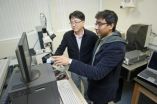(Press-News.org) COLUMBUS, Ohio – A new study comparing siblings who were fed differently during infancy suggests that breast-feeding might be no more beneficial than bottle-feeding for 10 of 11 long-term health and well-being outcomes in children age 4 to 14.
The outlier was asthma, which was associated more with breast-feeding than with bottle-feeding.
The study also included an analysis of outcomes across families of different races and socioeconomic circumstances for comparison purposes, and those results matched other studies suggesting that breast-feeding's benefits to children outweigh bottle-feeding.
The lead researcher noted that there is a clear reason for that.
"Many previous studies suffer from selection bias. They either do not or cannot statistically control for factors such as race, age, family income, mother's employment – things we know that can affect both breast-feeding and health outcomes," said Cynthia Colen, assistant professor of sociology at The Ohio State University and lead author of the study. "Moms with more resources, with higher levels of education and higher levels of income, and more flexibility in their daily schedules are more likely to breast-feed their children and do so for longer periods of time."
Previous research has identified clear patterns of racial and socioeconomic disparities between women who breast-feed and those who don't, complicating an already demanding choice for women who work outside the home at jobs with little flexibility and limited maternity leave.
Colen's study is also rare for its look at health and education benefits of infant feeding practices for children age 4 to 14 years, beyond the more typical investigation of breast-feeding's effects on infants and toddlers.
Federal health officials have declared breast-feeding for at least six months a national priority, which could end up stigmatizing women who can't opt to nurse their babies, Colen said.
"I'm not saying breast-feeding is not beneficial, especially for boosting nutrition and immunity in newborns," Colen said. "But if we really want to improve maternal and child health in this country, let's also focus on things that can really do that in the long term – like subsidized day care, better maternity leave policies and more employment opportunities for low-income mothers that pay a living wage, for example."
The study is published in the journal Social Science & Medicine.
Demographic differences across families that can bias studies in favor of breast-feeding include parental race, age, marital status, family income, insurance coverage, the mother's education and employment, and whether a woman smokes or drinks during pregnancy.
"When we get more advantaged moms selecting into breast-feeding and we know those traits also will affect the health outcomes, it's not clear what's affecting an outcome like obesity – is it breast-feeding itself or those other background characteristics?" Colen said.
Colen used data from the 1979 cohort of the National Longitudinal Survey of Youth (NLSY), a nationally representative sample of young men and women who were between ages 14 and 22 in 1979, as well as results from NLSY surveys between 1986 and 2010 of children born to women in the 1979 cohort. The children were between ages 4 and 14 during the time period studied.
The NLSY79 is conducted by Ohio State's Center for Human Resource Research for the U.S. Bureau of Labor Statistics.
Colen analyzed three samples: 8,237 children, 7,319 siblings and 1,773 "discordant" sibling pairs, or children from 665 surveyed families in which at least one child was breast-fed and at least one other child was bottle-fed. The children who were differently fed in the same family represented about 25 percent of the siblings in the data.
For each sample, the researchers sought answers to two basic questions: Was at least one child breast-fed and, if so, what was the duration of breast-feeding?
The study measured 11 outcomes that are common to other studies of breast-feeding's effects: body mass index (BMI), obesity, asthma, hyperactivity, parental attachment (secure emotional relationships between parents and child) and behavior compliance, as well as scores predicting academic achievement in vocabulary, reading recognition, math ability, intelligence and scholastic competence. Colen constructed statistical models for the analysis.
As expected, the analyses of the samples of adults and their children across families suggested that breast-feeding resulted in better outcomes than bottle-feeding in a number of measures: BMI, hyperactivity, math skills, reading recognition, vocabulary word identification, digit recollection, scholastic competence and obesity.
When the sample was restricted to siblings who were differently fed within the same families, however, scores reflecting breast-feeding's positive effects on 10 of the 11 indicators of child health and well-being were closer to zero and not statistically significant – meaning any differences could have occurred by chance alone.
The outlying outcome in this study was asthma; in all samples, children who were breast-fed were at higher risk for asthma, which could relate to data generated by self-reports instead of actual diagnoses.
Some examples of differing benefits: Breast-feeding's beneficial influence on BMI decreased by 66 percent between siblings across families and siblings within families. The magnitude of the beneficial effects of breast-feeding for math, reading, vocabulary and intelligence declined by between 69 and 29 percent, respectively, when comparing data across families to data from within families.
"Instead of comparing across families we are comparing within families, completely taking into account all of those characteristics – both measured and unmeasured – that differ by family, such as parental education, household income and race/ethnicity," Colen explained.
These same differences between samples were found in the analysis of the effects of the duration of breastfeeding.
These findings have implications for health policy, she noted.
"If breast-feeding doesn't have the impact that we think it will have on long-term childhood outcomes, then even though it is very important in the short-term we really need to focus on other things," she said. "We need to look at school quality, adequate housing and the type of employment parents have when their kids are growing up.
"We need to take a much more careful look at what happens past that first year of life and understand that breast-feeding might be very difficult, even untenable, for certain groups of women. Rather than placing the blame at their feet, let's be more realistic about what breast-feeding does and doesn't do."
INFORMATION:
Colen co-authored the study with David Ramey, a Ph.D. candidate in sociology at Ohio State.
This work is supported by a grant from the Eunice Kennedy Shriver National Institute of Child Health & Human Development awarded to the Ohio State University Institute for Population Research.
Contact: Cynthia Colen, (614) 247-8135; Colen.3@osu.edu (Email is the best way to reach Colen.)
Written by Emily Caldwell, (614) 292-8310; Caldwell.151@osu.edu
Breast-feeding benefits appear to be overstated, according to study of siblings
Advantages of women who choose breast-feeding likely bias findings in previous research
2014-02-25
ELSE PRESS RELEASES FROM THIS DATE:
Smartphone-based voting technology may lead to fewer user errors
2014-02-25
Many U.S. counties have incorporated electronic voting technology, largely in response to well-publicized challenges related to older mechanical and punch-card models. Although these updated systems have solved some usability problems, they present a new set of issues for voters unfamiliar with the technology. A new study published in Human Factors examines how smartphone-based voting systems can be incorporated into the current large-scale election process.
"Current electronic voting systems have numerous issues - from usability and accessibility to security to the ...
New approach to chip design could yield light speed computing
2014-02-25
Every second, your computer must process billions of computational steps to produce even the simplest outputs. Imagine if every one of those steps could be made just a tiny bit more efficient. "It would save precious nanoseconds," explained Northeastern University assistant professor of physics Swastik Kar.
Kar and his colleague Yung Joon Jung, an associate professor in the Department of Mechanical and Industrial Engineering, have developed a series of novel devices that do just that. Their work was published recently in the journal Nature Photonics.
Last year, the ...
Geology covers Mars, the Moon, anthropogenic lead poisoning, earthquake hazards, and more
2014-02-25
Boulder, Colo., USA – The Geological Society of America's top journal, Geology, displays its multidisciplinary best in this latest posting. Earth science disciplines covered include geoarchaeology, climatology, invertebrate paleontology, sedimentology, geomorphology, seismology, planetary geology, geochemistry, glaciology, plate tectonics, mineralogy, and environmental and medical geology. Locations include Mars; Earth's moon; India; the Tibetan Plateau; the Saskatchewan River; L'Aquila, Italy; the Antarctic; Australia; the Andes; the San Andreas fault system; and Kume ...
Scientists twist sound with metamaterials
2014-02-25
WASHINGTON D.C. Feb. 25, 2014 -- A Chinese-U.S. research team is exploring the use of metamaterials -- artificial materials engineered to have exotic properties not found in nature -- to create devices that manipulate sound in versatile and unprecedented ways.
In the journal Applied Physics Letters, the team reports a simple design for a device, called an acoustic field rotator, which can twist wavefronts inside it so that they appear to be propagating from another direction.
"Numerous research efforts have centered on metamaterial-based devices with fascinating wave-control ...
Improvement in polymers for aviation
2014-02-25
We live surrounded by polymers and today, rather than come up with new polymers, there is a tendency to modify them in order to obtain new applications. Carbon nanotubes have excellent mechanical properties, are very tough, very rigid, and what is more, they conduct electricity. "The problem with them is that they get dispersed, in other words, it's very difficult to get them to blend with polymers," explained Iñaki Eguiazabal, a member of the Polymer Technology Group. That is why it is essential to come up with methods that will enablethe carbon nanotubes to have a ...
'Greener' aerogel technology holds potential for oil and chemical clean-up
2014-02-25
MADISON, Wis. – Cleaning up oil spills and metal contaminates in a low-impact, sustainable and inexpensive manner remains a challenge for companies and governments globally.
But a group of researchers at the University of Wisconsin–Madison is examining alternative materials that can be modified to absorb oil and chemicals without absorbing water. If further developed, the technology may offer a cheaper and "greener" method to absorb oil and heavy metals from water and other surfaces.
Shaoqin "Sarah" Gong, a researcher at the Wisconsin Institute for Discovery (WID) ...
Glycerol phenylbutyrate reduces hepatic encephalopathy events
2014-02-25
Phase 2 trial results published in the March issue of Hepatology, a journal of the American Association for the Study of Liver Diseases, suggests the potential for Glycerol Phenylbutyrate (GPB) to reduce hepatic encephalopathy episodes in patients with cirrhosis, with a safety profile similar to placebo.
Patients with hepatic encephalopathy experience neuropsychiatric symptoms that may range from mild confusion to coma. There is conflicting evidence on the link between elevated blood ammonia and hepatic encephalopathy. Poorly-absorbable disaccharides and antibiotics ...
Sensor-based irrigation systems show potential to increase greenhouse profitability
2014-02-25
COLLEGE PARK, MD--Wireless sensor-based irrigation systems can offer significant benefits to greenhouse operators. Advances in sensor technology and increased understanding of plant physiology have made it possible for greenhouse growers to use water content sensors to accurately determine irrigation timing and application rates in soilless substrates. The wireless sensor systems provide more accurate measurements of substrate moisture than qualitative methods, and can save irrigation water, labor, energy, and fertilizer. The authors of a report published in HortTechnology ...
Technique to create holes in graphene could improve water filters, desalination
2014-02-25
Researchers have devised a way of making tiny holes of controllable size in sheets of graphene, a development that could lead to ultrathin filters for improved desalination or water purification.
The team of researchers at MIT, Oak Ridge National Laboratory, and in Saudi Arabia succeeded in creating subnanoscale pores in a sheet of the one-atom-thick material, which is one of the strongest materials known. Their findings are published in the journal Nano Letters.
The concept of using graphene, perforated by nanoscale pores, as a filter in desalination has been proposed ...
Report details multiple commercial uses of wireless sensor networks
2014-02-25
ATHENS, GA--Managing the quality and quantity of freshwater resources is one of the most serious environmental challenges of the 21st century. Global population growth and increasing urbanization have resulted in increased competition for water resources among domestic, industrial, and agricultural users. Challenged to find ways to manage irrigation needs while recognizing the limitations of freshwater resources, many commercial horticulture operations are showing increased interest in the use of wireless sensor networks (WSN)--technology designed to both monitor and control ...
LAST 30 PRESS RELEASES:
University of Oklahoma researcher awarded funding to pursue AI-powered material design
Exploring how the visual system recovers following injury
Support for parents with infants at pediatric check-ups leads to better reading and math skills in elementary school
Kids’ behavioral health is a growing share of family health costs
Day & night: Cancer disrupts the brain’s natural rhythm
COVID-19 vaccination significantly reduces risk to pregnant women and baby
The role of vaccination in maternal and perinatal outcomes associated with COVID-19 in pregnancy
Mayo Clinic smartwatch system helps parents shorten and defuse children's severe tantrums early
Behavioral health spending spikes to 40% of all children’s health expenditures, nearly doubling in a decade
Digital cognitive behavioral treatment for generalized anxiety disorder
Expenditures for pediatric behavioral health care over time and estimated family financial burden
Air conditioning in nursing homes and mortality during extreme heat
The Alps to lose a record number of glaciers in the next decade
What makes a good proton conductor?
New science reporting guide published for journalists in Bulgaria
New international study reveals major survival gaps among children with cancer
New science reporting guide published for journalists in Turkey
Scientists develop a smarter mRNA therapy that knows which cells to target
Neuroanatomy-informed brain–machine hybrid intelligence for robust acoustic target detection
Eight SwRI hydrogen projects funded by ENERGYWERX
The Lundquist Institute and its start-up company Vitalex Biosciences Announces Strategic Advancement of Second-Generation fungal Vaccine VXV-01 through Phase 1 Trials under $40 Million Competitive Con
Fine particles in pollution are associated with early signs of autoimmune disease
Review article | Towards a Global Ground-Based Earth Observatory (GGBEO): Leveraging existing systems and networks
Penn and UMich create world’s smallest programmable, autonomous robots
Cleveland researchers launch first major study to address ‘hidden performance killer’ in athletes
To connect across politics, try saying what you oppose
Modulating key interaction prevents virus from entering cells
Project explores barriers to NHS career progression facing international medical graduates
Jeonbuk National University researchers explore the impact of different seasonings on the flavor perception of Doenjang soup
Two Keck Medicine of USC Hospitals named Leapfrog Top Teaching Hospitals
[Press-News.org] Breast-feeding benefits appear to be overstated, according to study of siblingsAdvantages of women who choose breast-feeding likely bias findings in previous research



